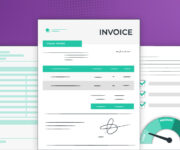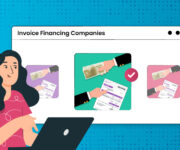There is usually a delay between the sale and receiving payment, which, for some businesses, takes longer to settle. To counter this issue, companies offer credit services to boost their sales, edge out competitors and build better customer relations.
However, in the meantime, the business also needs to continue its daily operations as usual, which requires a substantial amount of cash. This mismatch between inflow (from sales) and outflow (expenses) can result in a liquidity crunch or a working capital crisis for the business.
A U.S. Bank study revealed that 82 per cent of businesses failed due to poor cash management and lack of working capital.
Multiple working capital finance options are available for businesses, which allow them to run their operations smoothly. Invoice financing is one of the short-term finance options that helps firms manage their cashflows effectively. Just as its benefits, however, it comes with a few challenges for the lenders.
Read all about these challenges and how lenders can overcome them.
What Is Invoice Financing?
Invoice financing is a finance option that makes available future cash flows for present-day use to a business. This mode of finance unlocks the capital tied up in invoices that act as collateral against which the lender extends credit.
The business borrows cash against approved, unpaid invoices; the lenders pay the invoice value after deducting some margin and applicable fees. On receiving payment against these invoices, the borrower repays the advance amount, along with interest and charges, if any.
Challenges In Invoice Financing For Lenders
All lending comes with some risks, even if it is against some collateral, as in the case of invoice financing. Let us focus on four challenges faced by lenders when financing invoices.
1. Credit Risk
In invoice financing, the responsibility to collect the dues rests with the lender. If the customer fails to pay the amount on time due to insolvency, shortage of funds, or other reasons, the lender and the business will face losses.
Therefore, invoice financing comes with the risk of non-payment of dues, especially when it involves customers with poor credit ratings.
2. Fraud
Another risk lenders face while financing invoices is the risk of fraud. The company may present a fake invoice to the lender as collateral and seek funds against it, or in some instances, they may offer invoices of companies that do not exist.
This may lead to a company providing finance against an asset that does not exist. The lender will discover this months or weeks later when on the invoice due date.
3. Complexity
Each industry has its own set of norms and intricacies which lenders may not be aware of. The lack of in-depth understanding of the business and the company’s financial situation may result in poor management of receivables for the lender.
4. Concentration Risk
Focusing too much on a few clients can pose challenges for the lender if the client goes out of business or faces some financial challenges. This is known as concentration risk and can impact the lender’s cash flow and profitability.
How Can Lenders Overcome These Challenges?
Invoice financing is a valuable source of funds for MSMEs and powers their growth and profitability. It is a revenue source for lenders, albeit with its challenges. So, what can lenders do to mitigate this risk? Automation offers a solution to all these challenges in the following ways:
1. Improve the Review Process.
Reviewing invoices and clients before financing is a time-consuming and tedious procedure. Evaluating data from numerous invoices, credit notes, and receipts also makes the process prone to errors. Any mistakes or omissions at this stage could be costly for the lender.
Automation accelerates the review process and makes it more efficient and accurate by eliminating errors and enabling the processing of vast amounts of data in a much shorter span.
2. Mitigate Fraud
The best way to reduce the chances of fraud is to gather data from multiple sources. Application programming interfaces (APIs) help lenders gather insights from numerous sources and furnish critical information that helps mitigate fraud.
Finezza’s entire suite of solutions is available in the form of easy-to-integrate APIs that allow lenders to access information from several sources.
Loan management solutions with digital credit assessment, credit-collection analytics, and early-warning systems help detect and prevent fraud.
APIs and timely reporting are two instruments that can help working capital lenders reduce their risks extensively.
3. Credit Assessment and Risk Modeling
Data-driven solutions help lenders conduct exhaustive credit assessments and risk modelling. Integrating external data, like payment histories and industry trends, enables more accurate credit decision-making.
Apart from reducing default risk, it also allows lenders to have a more competitive pricing model commensurate with the customer’s risk profile.
4. Real-Time Monitoring and Predictive Analysis
Loan life cycle automation enables lenders to manage invoices and their portfolios in real time. Leveraging machine learning algorithms can help detect early warning signals of potential delays or defaults in invoice payments.
Accessing real-time data and timely reports like the borrower’s ageing report will help predict risk and take the necessary steps to manage it.
Moreover, Predictive Analytics is a great tool to help identify potential risks which are likely to occur and take timely actions to minimise them and reduce credit risk when financing invoices.
Finezza’s credit bureau data analyser, an AI-powered solution for lenders, helps manage lending risks based on pertinent credit data points.
5. Better Portfolio Management
Loan management systems (LMS) help lenders scale up their operations seamlessly. A good LMS should enable the lender to diversify their product ranges and enter new markets without much lag. A well-diversified portfolio with a mix of products and not focused on a few clients helps lenders reduce their concentration risk.
Regular monitoring also assists lenders in managing their portfolios, keeping them diversified and improving their yield.
The Takeaway
Invoice financing is a valuable source of funding for businesses as it helps them operate smoothly and is a vital revenue stream for lenders. Invoice-based financing provides lenders with good-quality credit and high returns.
Technological advancement and innovation offer lenders solutions to help them overcome the challenges they face in invoice financing and make it more rewarding.
Finezza’s loan management solution leverages the latest technological innovations that make invoice financing more efficient and help lenders overcome the challenges associated with this financing option.
Book a demo to discover more.




Leave a Reply